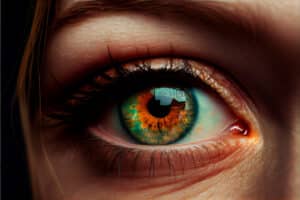

Disclaimer: This article is for informational purposes only and is not intended to diagnose any conditions. LifeDNA does not provide diagnostic services for any conditions mentioned in this or any other article.
If you’ve ever looked closely at your hairline and noticed a distinct V-shaped point, this is known as a widow’s peak. This feature is present in approximately 29.6% of women and 32.8% of men globally, making it a common yet intriguing aspect of human appearance. While it might seem like just another quirk of your hairline, a widow’s peak can actually tell us quite a bit about our genetic makeup and even some aspects of our health.
A widow’s peak is a unique and recognizable hairline feature where the hair forms a V-shaped point at the center of the forehead. This trait has an intriguing history, dating back to 18th century England when it was once believed to predict early widowhood. The name comes from the pointed hoods or hats that widows would wear as a symbol of mourning, and a similar shape in a hairline was thought to foreshadow future loss.
In reality, a widow’s peak is primarily a genetic trait, passed down through families. Specific genes influence the shape of the hairline, making the widow’s peak a distinct feature for some. However, genetics isn’t the only factor at play. The prominence of a widow’s peak can also be shaped by hair texture, growth patterns, and even the natural aging process. For some, the widow’s peak is sharp and noticeable, while for others, it might be a subtle curve or barely visible. These differences may be influenced by changes in hair growth over time, which may be affected by factors like hormones or overall hair health.
While the exact gene responsible hasn’t been definitively identified, it’s thought to be connected to hair growth patterns formed during early embryonic development.
A widow’s peak happens when the hairline develops unevenly during fetal development, forming a point in the middle of the forehead. This is a common and natural variation in how hairlines can look. While genetics is the main cause, factors like environment and overall health can also influence how a widow’s peak appears.
The heredity behind a widow’s peak isnot completely understood, but it is believed to be polygenic, meaning it is influenced by multiple genes, since no single gene or marker has been pinpointed as responsible. This complexity makes it difficult to predict the inheritance pattern of a widow’s peak with certainty. However, research into hairline genetics has identified several genes that may contribute to the development of this trait.
One gene that has been linked to hair growth patterns is the EDA (Ectodysplasin A) gene, which plays a crucial role in the development of hair follicles during embryonic growth. Changes in this gene can cause different hairline shapes, including the development of a widow’s peak. Another gene, FRAS1, has been associated with craniofacial development, which could indirectly influence the formation of a widow’s peak. However, the presence of a widow’s peak likely involves the interaction of multiple genetic factors rather than a single determinant.
This polygenic nature aligns with the inheritance of other complex traits, where several genes each have a small influence that together shape the final physical appearance. As research in genetics advances, particularly with the advent of genome-wide association studies (GWAS), we may gain a clearer understanding of the specific genetic pathways that lead to the development of a widow’s peak. Until then, the exact genetic mechanisms remain an area of ongoing research and discovery.
While a widow’s peak is usually just a normal variation in hairline shape, it’s worth noting that in rare cases, it can be associated with certain genetic syndromes. For most people, a widow’s peak is simply a benign genetic trait with no health implications. However, in some instances, a prominent widow’s peak can be one of several physical features linked to genetic conditions. For example, Waardenburg syndrome is a rare genetic disorder that can include a widow’s peak as one of its physical manifestations. This syndrome is characterized by a combination of pigmentary abnormalities (such as differently colored eyes), hearing loss, and distinctive facial features, including a pronounced widow’s peak.
Another condition linked to the presence of a widow’s peak is Aarskog-Scott syndrome, a genetic disorder that affects facial, skeletal, and genital development. People with this syndrome may display a widow’s peak, as well as other facial characteristics like a broad nasal bridge and a short groove between the nose and upper lip. These instances are exceptional, and a widow’s peak by itself is not an indication of a health problem. In most individuals, it is simply a genetic variation with no clinical significance. However, if a widow’s peak is accompanied by other unusual physical or developmental characteristics, it may need a further medical evaluation to rule out any underlying genetic conditions.
While genetics plays the primary role in determining the presence of a widow’s peak, environmental factors can also influence its appearance. These non-genetic factors may include:
These environmental factors, while not as significant as genetics, can still play a role in the development and appearance of a widow’s peak throughout a person’s life.
Hormones play a significant role in the development and maintenance of various physical traits, including a widow’s peak. For instance, during puberty, the surge in hormones such as androgens during puberty can influence overall hair growth patterns, but their specific impact on the prominence of a widow’s peak is not well documented. The appearance of a widow’s peak can be affected by various factors, including aging and hair loss, but the exact role of hormones on this specific trait remains unclear.
On the other hand, hormonal changes later in life, such as those occurring during menopause in women, can lead to the thinning of hair and a reduction in the prominence of a widow’s peak. Similarly, conditions that affect hormone levels, such as thyroid disorders, can also impact the appearance of the hairline. Hyperthyroidism, for example, can lead to hair thinning, including around the widow’s peak .
Hormonal fluctuations, particularly those related to conditions like polycystic ovary syndrome (PCOS) or during menopause, can also impact hair growth patterns. These changes might alter the appearance of the widow’s peak or the hairline in general, although the genetic foundation of the trait remains unchanged .
You Might Want to Read: Is Male Pattern Baldness Genetic?
A widow’s peak is primarily a cosmetic feature of the hairline and, in most cases, has no direct relation to an individual’s health. In very rare cases, a prominent widow’s peak has been observed in individuals with certain genetic or developmental conditions, such as Aarskog syndrome or Waardenburg syndrome. However, as indicated in the previous section, these conditions involve a wide range of symptoms, and the presence of a widow’s peak alone is not indicative of any health issue.
The skin and scalp around the widow’s peak can be prone to different skin conditions, potentially impacting the look and health of the hairline. For instance, conditions like seborrheic dermatitis, psoriasis, or eczema can lead to irritation, flaking, and hair loss around the hairline, potentially altering the appearance of a widow’s peak.
Seborrheic dermatitis, known for causing red, itchy, and flaky skin, often occurs in areas with a high concentration of sebaceous (oil-producing) glands, like the scalp. When it affects the hairline, it can cause discomfort and lead to temporary or even permanent hair loss if not properly managed. Similarly, psoriasis, an autoimmune condition that leads to the formation of thick, scaly patches of skin, can impact the hairline and cause hair to fall out in affected areas .
Maintaining good scalp hygiene and using appropriate skincare products can help manage these conditions and protect the areas near the widow’s peak. In some instances, medical treatments like corticosteroid creams or medicated shampoos might be needed to manage symptoms and protect the hairline from further damage.
Some people consider a widow’s peak to be a striking and attractive feature that enhances their individual appearance. However, for others, particularly those who experience significant changes in their hairline due to aging or hair loss, a widow’s peak might be a source of concern or even anxiety .
In the era of social media, where appearances are often scrutinized, the impact of a widow’s peak on self-image can be amplified. Understanding the genetic and natural basis of such traits may help individuals appreciate their uniqueness rather than view them as having flaws.
One of the common concerns for individuals with a widow’s peak, particularly as they age, is the potential for hair loss. Androgenic alopecia, also known as male or female pattern baldness, typically starts with hair thinning at the temples, which can make a widow’s peak more pronounced. In some cases, this condition can lead to the complete loss of the widow’s peak as the hairline recedes further.
While a widow’s peak can become more pronounced if hair loss occurs, particularly as the hair recedes around the temples, there is no strong evidence to suggest that having a widow’s peak increases the risk of developing androgenic alopecia.
A widow’s peak is generally a permanent feature, but like other hair-related traits, it can change over time due to factors such as aging, hair loss, and hormonal changes. As people age, their hairline may recede, which can either exaggerate or diminish the appearance of a widow’s peak. Additionally, hair loss conditions such as androgenic alopecia (male or female pattern baldness) can affect the hairline, sometimes leading to the complete loss of a widow’s peak.
For those who wish to accentuate or downplay their widow’s peak, there are several options available, both non-surgical and surgical.


